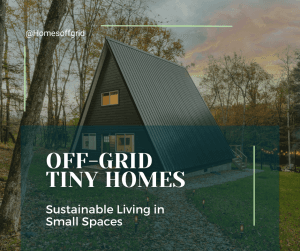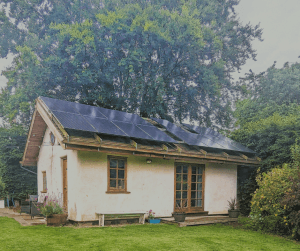The rise of off-grid tiny homes represents a significant evolution in sustainable living. These compact, efficient dwellings have gained popularity as more people seek to reduce their environmental footprint and embrace minimalist lifestyles. The appeal of tiny homes extends beyond their small size; they embody a shift towards simpler, more intentional living, making them a perfect match for the off-grid movement.
Explore the innovative design and construction of off-grid tiny homes, delve into their numerous benefits, and discover space-saving techniques that make these homes both functional and comfortable. Whether you’re considering a tiny home for financial savings, reduced environmental impact, or the appeal of a decluttered lifestyle, this guide will provide insights into making the most of small-space living while embracing sustainability.

Design and Construction
Innovative Designs in Off-Grid Tiny Homes
Off-grid tiny homes come in a variety of innovative designs that maximise space and efficiency. From sleek, modern container homes to rustic, cabin-like structures or quirky strawbale houses, these homes can be customised to fit personal preferences while ensuring functionality. Modular and prefabricated designs are a popular choice now, allowing for quicker construction and easier transportation. Many of these tiny home designs incorporate loft spaces for sleeping areas, fold-out furniture to save space, and large windows to enhance natural light and ventilation.
Sustainable Construction Techniques
Sustainable construction techniques are essential for building off-grid tiny homes. Builders often use reclaimed or recycled materials to minimise waste and reduce the carbon footprint. Utilising passive solar design principles, such as strategic window placement and insulation, helps regulate temperature naturally. Designing for natural ventilation through features like operable windows, and ventilation shafts can enhance indoor air quality and reduce reliance on mechanical cooling systems. Meanwhile, incorporating rainwater harvesting systems and composting toilets further enhances sustainability, making these tiny homes self-sufficient and environmentally friendly.
Use of Eco-Friendly Materials
The choice of materials plays a crucial role in the sustainability of off-grid tiny homes, though the choice available will depend greatly on the type of tiny home you are hoping to build. Eco-friendly materials like bamboo, reclaimed wood, and recycled metal are commonly used for construction. Utilising locally sourced and renewable resources such as adobe, or strawbale materials can even reduce energy consumption with its insulative properties. These materials not only reduce environmental impact but also provide durability and aesthetic appeal. Implementing green roofs or living walls can also improve insulation, reduce stormwater runoff, and provide habitat for local wildlife, promoting biodiversity. Additionally, non-toxic paints and finishes, along with energy-efficient appliances, contribute to a healthier living environment and greater overall sustainability.

Benefits of Off-Grid Tiny Homes
Financial Savings
Off-grid tiny homes offer significant financial savings compared to traditional houses. They are more affordable to build or purchase, and their smaller size means lower utility bills and maintenance costs. With a smaller space to heat, cool, and repair, homeowners can save money on energy and upkeep. Additionally, many off-grid tiny homes are mobile, eliminating the need for a permanent plot of land, which can further reduce expenses.
Reduced Environmental Impact
Living in an off-grid tiny home drastically reduces your environmental footprint. These homes are designed to be energy-efficient, utilising renewable energy sources such as solar or wind power. With lower energy consumption and sustainable construction practices, off-grid tiny homes contribute to less environmental degradation. Features like composting toilets, greywater recycling, and rainwater harvesting systems further enhance their eco-friendliness. Installing energy-efficient appliances and fixtures, such as low-flow water systems and LED lighting, reduces electricity and water consumption, also boost the home’s sustainability.
Simplified Lifestyles
Off-grid tiny homes encourage a simplified lifestyle, focusing on experiences rather than possessions. The limited space necessitates decluttering and prioritising essential items, promoting a more minimalist mindset. This shift can lead to greater mental clarity and reduced stress, as there is less emphasis on material goods and more on sustainable living and personal fulfillment. Additionally, the freedom and flexibility offered by tiny homes enable homeowners to live closer to nature and explore new environments.
Space-Saving and Optimisation
Creative Storage Solutions
Maximising space in an off-grid tiny home requires innovative storage solutions. Utilise vertical space with shelving and wall-mounted cabinets. Consider built-in storage options, such as drawers or shelves underneath stairs, window nooks with storage underneath or clever coffee tables with storage compartments. Hanging racks, hooks, and door hangers can also help keep your space organised and clutter-free.
You can even make use of the space beneath the floorboards for additional storage. Lift-up floor panels can conceal storage compartments for items like shoes, seasonal clothing, or bulkier equipment. Meanwhile, installing overhead racks or nets suspended from the ceiling provides storage for items like bicycles, camping gear, or rarely used belongings. This maximises vertical space and keeps floors clear.
Multi-Purpose Furniture
Investing in multi-purpose furniture is key to optimising a tiny home. Look for pieces that serve multiple functions, like sofa beds, fold-out tables, and ottomans with storage inside. Murphy beds, which fold up against the wall when not in use, can free up valuable floor space, while ottoman beds provide a spacious storage area with easy access. Modular furniture that can be rearranged or reconfigured is also ideal for maximising versatility.
Integrate fold-down desks or workspaces that can be tucked away when not in use, providing a dedicated area for work or hobbies without sacrificing valuable living space.
Efficient Layout Designs
Designing an efficient layout is crucial for a functional off-grid tiny home. Open floor plans can create a sense of spaciousness, while strategic placement of windows, mirrors and skylights can enhance natural light and ventilation. Consider sectioning your home into distinct areas for sleeping, cooking, and living to ensure each space is utilised effectively. Incorporate sliding doors or curtains instead of traditional doors to save space.

Common Misconceptions and Practical Considerations
Addressing Misconceptions About Tiny Home Living
One common misconception about tiny home living is that it’s only for minimalists or those willing to sacrifice comfort. In reality, tiny homes can be designed to be just as comfortable, functional and – with the right design techniques – maximalist as traditional homes, with amenities like full kitchens, bathrooms, and even entertainment systems. Another misconception is that tiny homes are temporary or not durable. Modern tiny homes are built to last, using high-quality materials and construction techniques that ensure longevity and resilience.
Legal Regulations and Zoning Considerations
Navigating legal regulations and zoning laws can be a challenge for tiny home enthusiasts. It’s important to research and understand local building codes and zoning requirements, which can vary widely by location. Some areas have specific regulations regarding the minimum size of dwellings, placement on property, and utility hookups. It’s also crucial to obtain the necessary permits and inspections to ensure your tiny home complies with all legal standards. In some regions, tiny home communities have emerged, providing a supportive environment with shared resources and infrastructure.
Integration into Off-Grid Communities
Integrating into off-grid communities can greatly enhance your tiny home living experience. Tiny home villages, where groups of tiny homes are built to form onsite communities, are becoming increasingly popular. These villages offer a sense of community and shared resources, such as communal gardens, shared utility systems, and common areas for socialising. Living in a tiny home village provides the benefits of a supportive network while maintaining independence.
Additionally, the online community for tiny home enthusiasts is vibrant and extensive. Online forums, social media groups, and dedicated websites offer a platform for sharing experiences, tips, and advice. Connecting with others online can provide inspiration, practical solutions, and a sense of belonging to a larger movement of sustainable living. Whether in a physical village or a virtual community, the support and friendship found in these communities can make the transition to tiny home living smoother and more enjoyable.
Off-Grid Tiny Homes vs. Other Off-Grid Options
Comparing Tiny Homes to Traditional Off-Grid Homes, Campervans, and Boats
Off-grid tiny homes offer a unique blend of affordability, sustainability, and flexibility, setting them apart from other off-grid living options. Compared to most traditional off-grid homes, tiny homes are more affordable and quicker to construct. They require fewer materials and less land, making them an attractive option for those looking to minimise their environmental footprint and investment.
Campervans provide mobility, allowing residents to travel and live off-grid in various locations. However, they often have limited space and amenities compared to tiny homes. Boats offer the allure of living on water, providing a unique lifestyle and the ability to move with the tides. Yet, they also come with specific challenges such as maintenance, mooring fees, and the need for specialised knowledge.

Crossovers and Shared Benefits
All these off-grid living options share common benefits, such as reduced environmental impact and the potential for financial savings. They promote a minimalist lifestyle, encouraging individuals to prioritise experiences over possessions. Both tiny homes and campervans can utilise renewable energy sources like solar panels, reducing reliance on traditional power grids.
Moreover, tiny homes, campervans, and boats all foster a strong sense of community among their residents. Whether through physical communities, or online, individuals living off-grid often find support and solidarity among like-minded people.
Which Option Suits Your Individual Preferences and Needs?
Choosing the right off-grid living option depends on personal preferences, lifestyle needs, and financial considerations. Tiny homes are ideal for those who want a more permanent, eco-friendly residence with the comfort of a traditional home. They offer stability and the ability to customise space according to individual needs. You can also make use of the land your tiny home is situated on, extending your living space outdoors.
Campervans are suitable for those who value mobility and the freedom to travel. They are perfect for adventurers who want to explore different landscapes while maintaining an off-grid lifestyle. Boats cater to those who are drawn to water and enjoy the unique challenges and rewards of maritime living.
Ultimately, the best choice will depend on one’s priorities, whether it’s the comfort and customisation of a tiny home, the mobility of a campervan, or the unique lifestyle of living on a boat. Each option offers distinct advantages and can provide a fulfilling and sustainable off-grid living experience.
Conclusion
Off-grid tiny homes present a compelling solution for those seeking sustainable, minimalist living. They offer significant financial savings, reduced environmental impact, and a simplified, more intentional way of life. The innovative designs and sustainable construction techniques ensure that these small spaces are both functional and eco-friendly.
By maximising space-saving techniques and creative storage solutions, and incorporating eco-friendly materials, off-grid tiny homes offer an innovative solution for those looking to minimise their environmental footprint while enjoying the comforts of home.
Ultimately, off-grid tiny homes exemplify the principles of sustainable and responsible living in small spaces. By embracing this lifestyle, individuals can contribute to a more sustainable future while enjoying the freedom and simplicity of living off the grid. Take the first step towards a fulfilling and eco-conscious off-grid tiny home lifestyle.

To find out more about off-grid living visit the Reading Room here.


